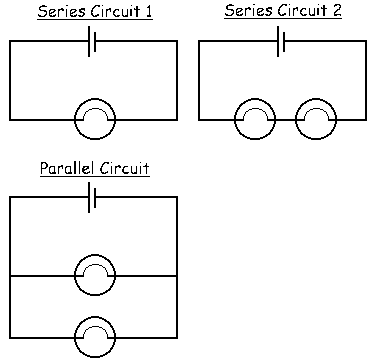
 Electric Current
Electric Current involves electrons repelling one another and passing through a conductor.
Ex. The pumping station provides the water with gravitational potential energy, pumping it up into the water tower. the water then later loses this energy as it is piped through the sprinkler and back to its point of origin. the same thing occurs in an electric
circuit. The energy source provides electrons with energy and the electrons are transported by the conductors through the circuit and then back to the source to be re-energized.
The
rate of charge flow can be calculated using this expression:

I is the symbol given to calculate the rate of charge flow in amperes (A)
Q is the charge in coulombs (C)
t is the time in seconds (s)



Once upon a time, current flow was believed to move from the positive (+) terminal to the negative (-) terminal on any power supply. it is now well understood that, in actuality, current is a flow of negatively charged electrons repelling one another.to keep track of this, a colored wiring convection is used in which black represents the negative terminal and red represents the positive terminal of any power supply.
Definitions:
♦
Electric Current is the flow of charge.
♦
Current is the rate of charge flow.
♦
Conventional current is a model of positive charge flow.
♦
Direct current or DC is the current flow in a single direction from a power supply through the conductor to a load and back to the power supply.
♦
Alternating current or AC occurs when the electrons periodically reverse the direction of their flow.
♦
Circuit is the path of the current and is required for any electrical device to work properly.
♦
Voltmeter is a device that measures the difference between any two points.
(Must be connected in parallel with a load in order to compare the potential)





 .) So anyways...
.) So anyways... ) what we did next was add 2 more papers (same shape), that were smaller in width (or in this case diameter since our rectangles weren't exactly rectangles) than the one before to make the bottom as strong as possible. On the last one, we pinched the 2 corners, and ended up with a very small hole, just big enough to fit the 2 attached tubes (which we made by rolling up the paper). This added lots of height to our structure but it wasn't until one more thing to it that it ended up being the tallest out of the entire class (out of 8 others). After everything the only thing that was left was a very long strip of paper that we had cut from the previous paper that we used at the beginning. My partner had the smart idea of just folding it in half and just sticking it inside the tube. that added about a good 30cm to the total height of our structure and made us th winning team of the activity!!!
) what we did next was add 2 more papers (same shape), that were smaller in width (or in this case diameter since our rectangles weren't exactly rectangles) than the one before to make the bottom as strong as possible. On the last one, we pinched the 2 corners, and ended up with a very small hole, just big enough to fit the 2 attached tubes (which we made by rolling up the paper). This added lots of height to our structure but it wasn't until one more thing to it that it ended up being the tallest out of the entire class (out of 8 others). After everything the only thing that was left was a very long strip of paper that we had cut from the previous paper that we used at the beginning. My partner had the smart idea of just folding it in half and just sticking it inside the tube. that added about a good 30cm to the total height of our structure and made us th winning team of the activity!!!  hehe.
hehe.  . if you're interested in whats being said here's the link:
. if you're interested in whats being said here's the link: 




